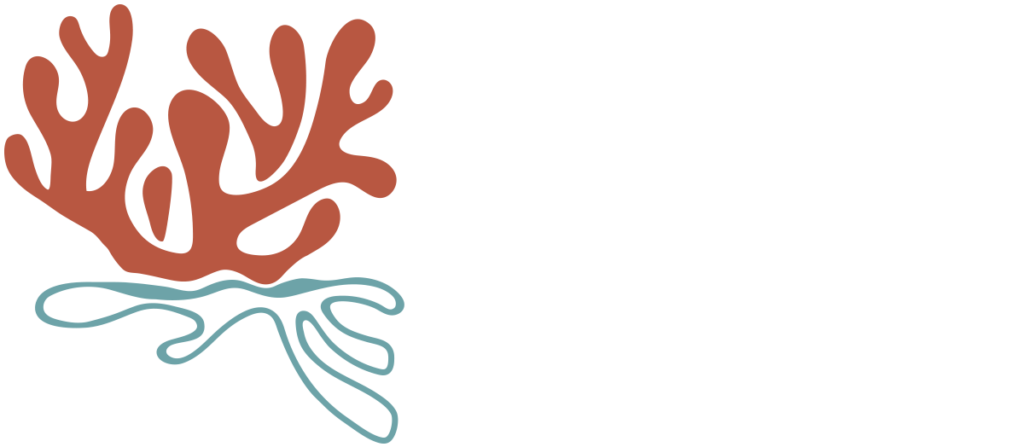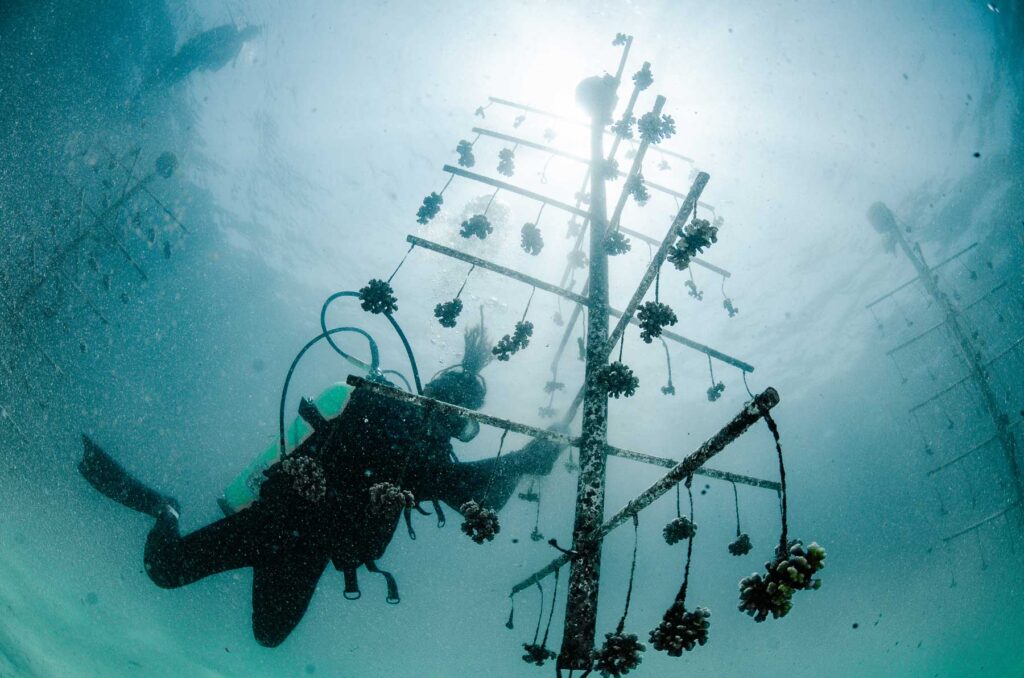The expansion phase of the project began in July 2022, following a clear protocol for coral cultivation and transplantation based on our previously earned experience.
Our team integrated the lessons learnt from our pilot to create a perfected and expanded nursery, which allowed for the cultivation of more than 2400 mature corals of 10 different species and 3 different genus, corresponding to more than 50 coral varieties from southern Isabela island (Link to “Southern Isabela coral baseline”).
Methods
The project has employed three restoration techniques: coral nursing, direct transplants and reef repair.
Coral nursing: The backbone of our work relies on utilizing coral gardening to reproduce and cultivate corals until they reach enough size to be transplanted back to the reef. We have constructed underwater coral nurseries to rear the scarcest and most threatened genotypes in southern Isabela, in an effort to increase their representation and create redundant populations.
During this period, different techniques and methodologies have been implemented for cultivating a range of coral species and morphologies, allowing us to implement three different systems:
- Rope nursery: Identified during the pilot phase as the most efficient and easiest to implement, this system is perfect for rapidly increasing coral abundance. It involves ropes suspended over a metal structure and is ideal for reproducing corals in great numbers. However, this system requires intensive cleaning and maintenance to ensure healthy coral growth, lowering survivorship rates due to competition with algae.
- Tree nursery: The vertical structure allows corals to be cultivated suspended in the water column, making efficient use of the cultivation area and nursery space. It proved to be a highly effective technique, increasing coral survivorship rate and requiring limited cleaning and maintenance. However, constructing this structure requires a relatively higher budget for its limited rearing capacity. Tree nurseries have proved ideal for cultivating fragile corals or those highly susceptible to fragmentation.
- Table nursery: This system consists of a submerged platform resembling a table, used for cultivating massive corals of the Porites and Pavona genera. Our team has perfected the micro-fragmentation technique in order to rear these slow-growing species. Micro-fragmentation is a method that consists of cutting corals into small fragments the size of a finger nail in order to accelerate growth rate by over 40X. We have implemented lava rock as substrate to create coral cookies, small plate-like material that serves as anchoring ground for micro fragment attachement. In order to increase complexity, we have partnered with the design lab of USFQ to create the first module for constructing a massive coral substrate, enhancing cultivation and growth.
In order to accelerate our restoration efforts our team has incorporated different restoration approaches.
Direct transplants: This methodology involves collecting naturally broken fragments of opportunity and transplanting them directly to the marine substrate, avoiding the lengthy and labor-intensive process of coral nursing. Direct transplants have proven to be a useful tool to increase coral cover, albeit with a higher mortality. This methodology is only suitable where coral fragments are found in great numbers, which limits its applicability to use with scarce coral varieties.
Reef repair: Our team periodically implements a reef repair, a passive restoration technique focused on stabilizing dislodged or broken corals affected by storms, surges or human activity. Reef repair is usually undertaken after a strong disruptive event, allowing to relocate or stabilize large coral heads to prevent damage.
Results
2022-2023
Our restoration efforts initiated in early 2023, as soon as water temperatures normalized after “La Nina”. We have identified a cultivation cycle of at least 10 months, which meant that during the first trimester of the year, our team has focused solely on restoring via direct transplants, until nursery corals were mature enough to be transplanted.
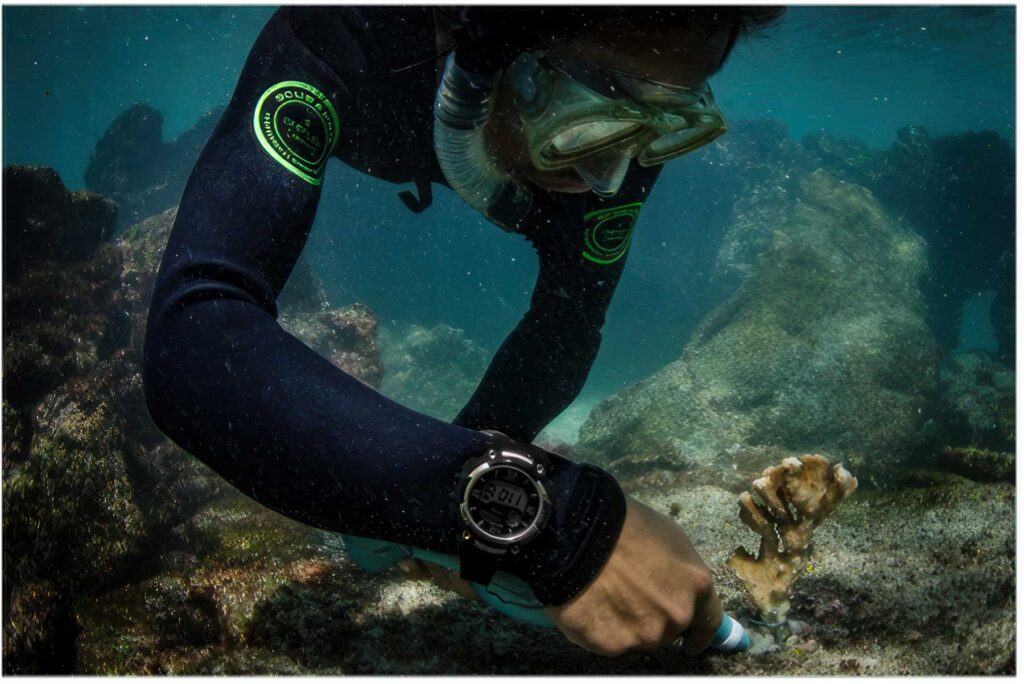
In order to ensure restoration success, trials were conducted at three potential restoration sites along the historical coral cover of “La Calera” allowing our team to identify the most suited areas for coral survival and performance. These trials provided valuable insights into the suitability of each locality and the fitness of different coral varieties for direct transplanting.
As a result, two coral populations and three sites were selected for large-scale direct transplanting operations. The positive preliminary results with direct transplants have allowed for the incorporation of this method as an active tool to rapidly increase coral cover, allowing the restoration of approximately 1750 corals with survivorships ranging from 97% to 75%.
By the second trimester of 2023, our nursery corals had grown big enough to be transplanted. Being the first major marine restoration effort in the islands, it was important to share this next phase with the local authorities and stakeholders. Supported by the Galapagos National Park we carried out a general assembly to socialize with the local community the nature of our out-planting operation, detailing the work being done, the restoration area and the management measures needed to protect it. With their approval, Reef Revival initiated its first major out-planting operation in August of 2023.
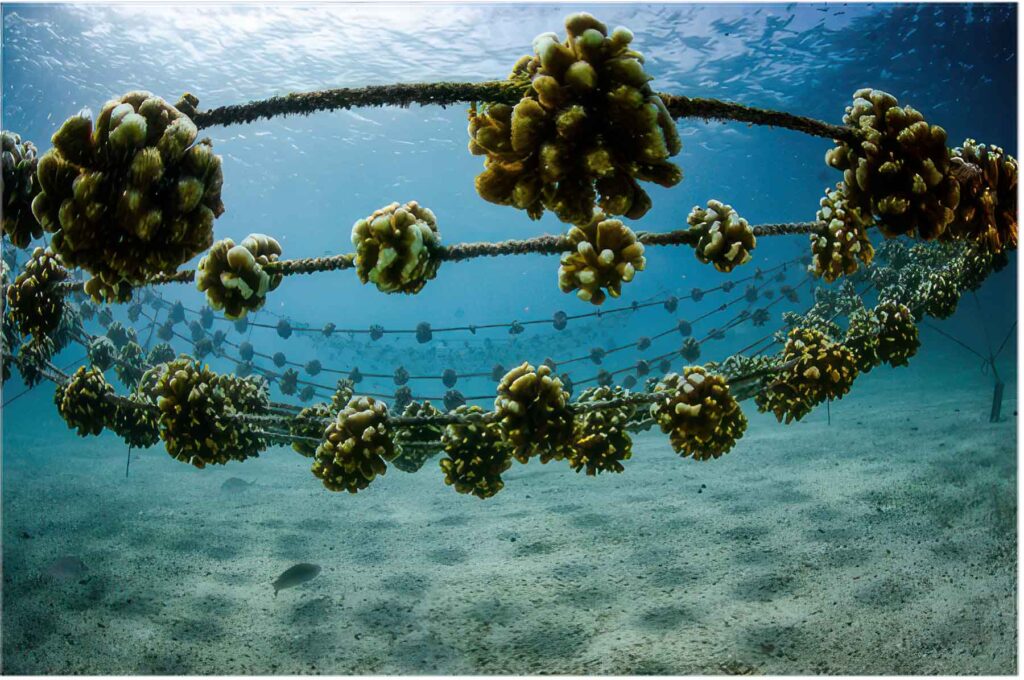
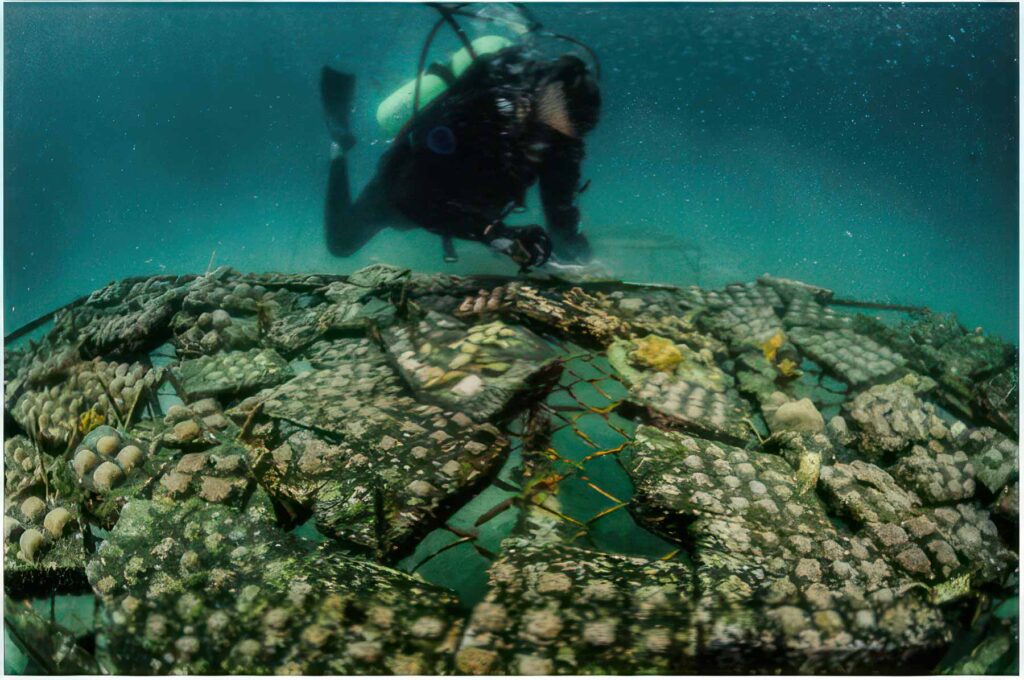
“La Calera” is an extinct reef spanning more than 7 hectares. Being such a large area meant that we had to first focus our efforts on the best suited zones for restoration. For this purpose, we undertook several outings, working closely with the Galapagos National Park authorities to selected the best strategic location for restoration. In a general consensus we selected the southwest end of the historical reef as our focus area. The selected location not only counted with all the necessary conditions for healthy coral growth, but also worked as a strategic point, serving as a massive coral seeder for spreading coral fragments and larvae.
It took our team two entire months to outplant all of our reared nursery corals to the designated area. We worked out-planting a range of coral types in order to enhance diversity. In this way our team managed to restore more than 2530 corals, reestablishing 1000 m2 of coral cover back to “La Calera”. This major effort amounted to an overall restoration output of 4530 corals (including direct transplants), reestablishing a total of 2500 m2 by September of 2023
2023-2024
The rumors of a major “el Nino”event in 2023 created concern around the globe, and fear in the Galapagos community. Our team prepared itself for this major climatic event, training our staff to respond quickly to major heat waves and perfecting our coral-bleaching monitoring protocols. By June of 2023 we felt the first heatwaves in the Galapagos, although still fairly mild. Luckily, The height of el Nino coincided with the coldest time of the year in the islands (July – December), thus reducing overall sea surface temperature. The strength of the cold-water Humboldt current during the Galapagos cold season created a buffer effect, maintaining the overall sea temperatures fairly mild (25-26C), and providing for excellent conditions for healthy coral development.
Interestingly, as soon as the warm season began (January-June), the influence of el Nino started to fade, allowing water temperatures to return to normal with the onset of the sumer. This unique year has provided fairly stable water temperatures in the Galapagos, with warmer than usual winters (up to 5C SST anomaly) and fairly moderate summers, thus limiting seasonal shifts in ocean temperature and allowing for excellent coral rearing conditions.
The 2023-2024 rearing cycle supported one of the best survivorship rates that our team has observed so far. The mild seasonality during this unusual year created an astounding 91% survivorship in our nursery, and virtually 100% survivorship of our outplants.
By June of 2024, nearly after 10 months of rearing, our nursery corals had grown big enough to be transplanted out to the reef. We followed the methodology utilized in 2023 to transplant all our corals into the previously selected restoration area, increasing restoration size and density. Eventually after nearly two months of out planting, our efforts allowed us to transplant a total of 2000 corals back to the reef, amounting to a total restoration impact of 6730 corals by the bgining of September 2024.

